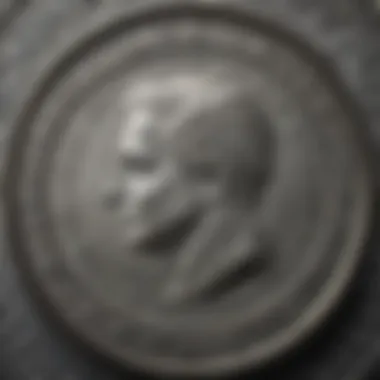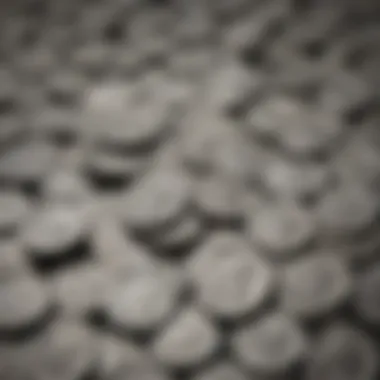The Intrinsic and Market Value of Dimes Explored


Overview of the Topic
Dimes have a rich history and significant presence in the world of currency. Defined as coins worth ten cents, they play a crucial role in everyday transactions and collectibles. While dimes serve a practical function in commerce, their intrinsic and market value can significantly diverge due to a variety of factors.
Understanding the intrinsic value encapsulates the worth of the metal content and collection rarity, while market value often relates to trends in coin collecting and speculation. The coexistence of these two values imbues dimes with a unique role in both monetary and collector realms.
Key Benefits and Implications
- Historical Importance: Dimes have evolved both in design and value since their inception in the early 1790s. Knowing the historical context adds depth to their appreciation.
- Investment Opportunities: Rare dimes can be a vehicle for investment, often leading to significant financial appreciation over time.
- Collectible Market: The vast array of minting years and conditions make dimes an interesting area of exploration for collectors, showcasing a spectrum of varieties and potential pitfalls.
The analysis of dimes encompasses more than mere coinage. It includes understanding market dynamics, trends in collectibles, and the economic environment affecting denomination values.
Examining Market Value
To gain clarity on the market value of dimes, several differentiating factors come into elucidation. Dominant determinants include minting years, condition, and popularity among collectors.
- Minting Years: Coins released in certain years can command higher values. For example, dimes minted in 1894-S and others during wartime show heightened worth.
- Condition: The grade or state of preservation plays a pivotal role. Coins deemed 'uncirculated’ fetch higher prices than those that have circulated extensively.
- Collector Demand: The popularity of specific editions, influenced by trends, tends to oscillate, allowing certain dime types to surge in value unexpectedly.
Keeping these elements in mind is essential when evaluating the financial implications and collector aspects associated with dimes.
Strategies for Value Assessment
When measuring the worth of dimes, it helps to follow a structured approach. Here are practical tips for implementing an effective method for assessment:
- Research Market Trends: Regularly review guides and resources that provide updates on current valuations. Websites like numismaticnews.net offer insights into market fluctuations.
- Utilize Grading Systems: Familiarize yourself with grading systems such as the Sheldon scale, as a proper assessment can convert mere numbers into estimated value.
- Visual Inspection: Use quality magnification tools to examine coins for any defining characteristics and assure proper valuation.
Each step plays a integral part in conducting thorough assessments. A disciplined approach avoids misunderstandings around dime value.
Real-World Insights on Investment
Exploring historial and case-specific examples elucidates the practical aspects of dealing with dimes. Multiple collectors have effectively translated their interest into profit through acquisitions and timely sales.
For instance, a suburban collector found a 1943 Mercury dime in a change purse. Recognizing its rarity, they profited by over $500 after listing it on a specialized marketplace. Conversely, a deeper dig into haphazard versus informed collections exposes situations where one can easily download excess value by not doing adequate due diligence before purchases.
Understanding the Basics of Dimes
Understanding dimes is crucial when exploring their value. Dimes may seem insignificant, but they offer insights into American history, economics, and collectibles. Knowing the basics can provide readers with a deeper appreciation of these small coins that hold substantial importance.
Definition and Importance of Dimes
A dime is a coin that represents ten cents in United States currency. It is smaller than both the quarter and the nickel. For many years, dimes have signified purchasing power, and their value as legal tender is essential for daily transactions. Unlike many other coins, dimes are recognized not just for their monetary value but also for their historical significance.
Importance of dimes includes:
- Monetary transactions: They facilitate everyday purchases and services, maintaining fluidity in commerce.
- Historical value: Dimes reflect societal changes and shifts in economic principles. They represent the nation's evolving story, showcasing various designs over time.
- Collectibility: Many individuals engage in coin collecting, making rare dimes of significant value. The recognition of collectible dimes emphasizes their importance beyond mere currency.
In the broader context of coinage and personal finance, understanding dimes helps appreciate their role in our economy. As we delve deeper, we will examine their historical background, providing essential context regarding their journey and evolution.
Historical Background of the Dime
The history of the dime stretches back to the late 1700s. The first official paper print of “dime” originated in the Coinage Act of 1792, which allowed for the minting of various coins, including the dime. Initial design featured an image of Liberty, known as the Draped Bust dime.
Over the years, several designs surfaced, ideally reflecting the cultural and political milestones in U.S. history. These changes not only brought visual diversity but also affected the dime's value.


Key periods include:
- Liberty Seated Dime (1837-1891): A turn of artistic styles where the image of Liberty seated became prevalent.
- Barber Dime (1892-1916): Marked by its detailed probabilities of high artistry, it bore the bust of Charles E. Barber.
- Mercury Dime (1916-1945): Rare designs led to exquisite traits and has numerous admirers.
- Roosevelt Dime (1946-present): A historical adaptation that marks post-war representation.
Each design change corresponds with sociopolitical climates, reflecing American life in distinct eras. This intricate history enhances the understanding of dimes, setting the stage for delving into their materials and composition.
Composition of Dimes
Understanding the composition of dimes is vital in appreciating their value and significance, both as currency and collectible items. The materials and manufacturing processes employed play an integral role in determining both the intrinsic and market value of these coins.
Materials Used in Dime Production
Dimes are made primarily from copper and nickel. The composition has changed over the years, but the modern dime consists of a core made from pure copper that is clad with a nickel alloy. Specifically, the dime is composed of 91.67% nickel and 8.33% copper, giving it durability and resistance to wear.
When dimes are minted, their metallurgical composition is crucial for durability. The specific blend of metals enhances the coin's longevity in circulation. This is particularly important because dimes often change hands frequently compared to larger denomination coins or bills.
Events can alter the approach to minting materials. For instance, during times of metal shortages, the government might explore alternative materials just as historical events have guided previous changes. However, any significant advancements in coin production materials must meet government standards ensuring the coin's authenticity and viability in everyday transactions.
Changes in Composition Over Time
Historically, the metals used in dimes have gone through notable transitions. Before 1965, dimes were composed of 90% silver and 10% copper. This was fundamentally different from the current design, most relevant during a period when the intrinsic metal value often exceeded its face value.
In 1965, facing coin shortages and increased silver prices, the U.S. Mint decided to replace the silver content with a more cost-effective copper-nickel blend. Consequently, this transition addressed both the functional and economic needs of the currency at the time focused on circulation rather than intrinsic value.
To properly grasp the worth of existing dimes, it is essential to recognize these shifts components play. A dime manufactured prior to 1965 not only has collectible appeal but also intrinsic value just from its silver content. Meanwhile, post-1965 dimes do not hold this same level of intrinsic value, making analysis grounded in historical context important for collectors and investors alike.
Understanding the composition of coins like dimes is fundamental for collectors, since value is influenced significantly by both metallic content and historical context.
By recognizing both the materials and the historical shifts in their composition, one can make informed judgments about their worth in terms of currency and collectible value.
The Face Value of Dimes
Understanding the face value of dimes is vital in grasping their overall significance in monetary transactions. The face value represents the nominal worth written on the coin, but it does not encompass the full scope of value possessed by these coins as collectibles. This section aims to provide a clear understanding of both the current face value of dimes and their legal tender status.
Current Face Value of Dimes
As of now, the face value of a dime is ten cents. This value remains unchanged throughout its circulation. It is important to note that while this denomination stands universally recognized, the actual buying power can fluctuate due to various economic factors.
The coin, made primarily for convenience in daily transactions, plays a modest but essential role in our economy. With vendors in various forms of commerce accepting them, dimes support small exchanges and streamline purchases. While dimes may not hold significant individual purchasing power, collectively, they contribute profoundly to the functioning of cash-based transactions.
Coins of this denomination are often utilized in the U.S. national treasury and heavily circulated among consumers. Dimes can be interchanged for other coins or paper currency, thereby maintaining their practical relevance. In summary, the intrinsic face value anchors dimes in commerce, linking the abstract notion of currency value to tangible buying power.
Legal Tender Status
The legal tender status of dimes grants them further importance beyond their face value. Legally, dimes are mandated to be accepted in settling debts, facilitating ease in transactions and promoting overall trust in the currency system. This means all debts, which are payable in money, can be settled using dimes, alongside other dollar-denominated currency.
This is supported by U.S. law, which defines legal tender, permitting any properly minted coins to serve in economic activities. While individuals and businesses can choose specific payment methods, such as checks or online transactions, dimes and other coins remain important due to their status.
Market Value of Dimes
The market value of dimes is a critical aspect to understand when evaluating their place in both numismatics and personal finance. Unlike the face value, which stands at tough ten cents, market value often varies based on various factors—much like any asset in financial sectors. This topic showcases how enthusiasts and investors regard dimes not merely as change, but as potential sources of capital growth.
Factors Influencing Market Value


Several elements determine the market value of dimes, beyond mere age and condition. Here are the main factors:
- Mint Year: Dimes produced in certain years tend to be valued more than those from others. For instance, the 1894-S Barber dime is known for its extreme rarity and has fetched prices in the six-figure range at auction.
- Condition Grade: The grade of a dime, assessed through coin grading systems, significantly impacts its market value. Higher-grade coins (for instance, MS 65 or higher) will generally yield more on the market compared to dimes with visible wear and tear.
- Rarity: Coins that are minted in lower numbers or with errors captured during production hold more value. A coin with misstrikes or failed strikes, like the 1982-P no mint mark Roosevelt, adds layers of collectibility and investment appeal.
- Collector Demand: Demand for collectible dimes influenced heedlessly by broader market trends. A growing interest in coin collecting on platforms like Reddit can elevate market values beyond typical expectations.
Understanding these factors assists investors in making informed choices and highlights the importance of researching dimes intensely before any purchase.
How to Assess Market Value
To accurately gauge the market value of a dime, one can utilize several strategies:
- Research Market Trends: Websites like eBay and auction houses frequently provide insight into recent sales and price fluctuations.
- Check with Collectors: Engaging with numismatic communities can offer informed opinions on current values and applicant demand levels, especially on platforms like Reddit where discussions about coin values are lively.
- Consult Price Guides: Publications and digital resources such as the
Collectible Dimes
The significance of collectible dimes extends beyond their face value. Collectible dimes often represent a intersection of history, artistry, and potential financial gain. Enthusiasts and collectors see dimes not just as coins but as tangible connections to particular moments in American history. They gain interest through various factors, like rarity, design, and age, making them a complex topic worth examining.
Types of Collectible Dimes
Dimes come in various types, and their categories often reflect historical contexts or specific features. Here are some notable collections among enthusiasts:
- Mercury Dimes: Minted from 1916 to 1945, these coins gained popularity for their detailed designs. The obverse features a representation of Liberty that many collectors admire.
- Roosevelt Dimes: First produced in 1946 following Franklin D. Roosevelt's death, these coins symbolize a more modern collectible segment. They hold sentimental value, especially among those reshaping their financial lives.
- Winged Liberty Head Dimes: Commonly known as
Authenticating Dimes
Authenticating dimes is a crucial aspect of coin collecting and investment. As collectible coins, dimes can be both valuable in face value and as part of a collection. Many factors influence the worth of these coins, making it vital to discern between genuine and counterfeit dimes. Common counterfeits can mislead collectors, reducing the overall trust in the market. Understanding authentication methods helps protect important assets and guides investment decisions.
Common Counterfeit Dimes
Counterfeit dimes have been a persistent issue in coin collecting. Fraudsters often create copies of valuable or famous dimes, attempting to pass them off as legitimate coins. Commonly counterfeit variants include specific grading exceptions and certain years known for their rarity and worth. Dimes from various minting years can have varying degrees of importance, potentially attracting counterfeiting efforts from malicious individuals aiming for quick profit.
"Fakes often replicate high-value coins but lack slight intricacies that make them unique."
Some indicators to identify counterfeit dimes include:i
- Weight Discrepancy: Genuine dimes have specific weights, whereas fakes may differ due to materials used.
- Appearance: Fakes can appear shiny or poorly struck compared to authentic dimes.
- Edge Details: The edge of an authentic dime has a distinct profile that a counterfeit might fail to reproduce.
Understanding these signs provides collectors confidence when purchasing or trading.
Methods for Authenticating Coins
Engaging in methods to authenticate coins assures collectors they possess legitimate assets. Several techniques are used primarily by expert numismatists and those seriously involved in collecting. Effective verification techniques currently include:
- Magnification and Inspection: Using magnifying tools like loupes helps detect minute details which differentiate quality coins from counterfeits.
- Weight Readings: Professional scale can provide accurate measurements to validate if a coin's weight matches the specific dimes against standard values.
- Reference Guides: Consulting numismatic books, guides, or digital resources offers chronological data and clear images of expected features on genuine dimes.
Successful authentication not only boosts collector confidence but serves as an asset preservation strategy. Affirming a dime's genuineness requires both knowledge and appropriate tools.
Investors in dimes should consistently evaluate their collections and stay informed on new tendencies in counterfeiting practices. By ensuring a careful appraisal process, collectors enhance their ability to sustain and maximize their investments over time.
Investment Considerations
Understanding how dimes can serve as a form of investment is essential for collectors and those looking to diversify their portfolios. While these coins are often seen primarily as a mere payment method, the potential investment benefits cannot be overlooked. Various aspects, such as historical significance, rarity, and market demand, elevate the position of dimes within the realms of both numismatics and personal finance.
Dimes as an Investment


When evaluating dimes as an investment, different factors warrant consideration. Intrinsic value is one consideration. Dimes are typically made of precious metals like silver, which adds to their overall appeal in an investment context. Collectors often seek out dimes based on their national significance, such as those minted for specific commemorative events. Higher-grade examples can command substantial premiums on the open market.
Moreover, minting years play a critical role in value. Many investors prefer certain key dates or limited production runs, which can manifest considerable appreciation over time. It's important to examine the condition of the dime, as those in uncirculated or pristine condition will naturally attract higher valuations. The value of dimes can indeed fluctuate based on economic indicators, forcing investors to stay informed.
Long-Term vs.
Short-Term Holding
Investors must carefully weigh the strategies of long-term versus short-term holding when entering the dime market. Long-term investments tend to involve coins that appreciate steadily over time, appealing to those who are willing to sit on their investments. Such an approach might integrate buy and hold philosophies, which allow time for the market to yield meaningful returns. Holding coins for extended durations allows market knowledge to blend with the coin's material worth.
On the other hand, short-term holdings often call for a more dynamic strategy. Speculative approaches may be tempting, especially when perusing stock lists or upcoming auctions for immediate gains. However, flipping dimes rapidly comes with its own set of challenges such as transaction costs and price volatility. Each strategy should align with individual investment goals and risk tolerance while paying heed to the market conditions that may affect the outcomes.
Investing in dimes can open doors to both financial returns and historical appreciation, depending on your approach and criteria.
Ultimately, whether an investor is drawn to dimes for their market appreciation potential or historical significance, a well-researched and calibrated approach is critical. %
Dimes in Everyday Transactions
Dimes play a significant role in modern commerce, though their importance can be overlooked. Understanding their practical utility enhances one's grasp of the changing landscape of currency use. This section looks into the role of dimes in everyday transactions and examines how their use interacts with evolving payment methods.
Use of Dimes in Modern Commerce
Dimes, though small in face value, maintain relevance in everyday transactions. Almost all businesses that deal with cash include dimes as part of their operations. In customers’ pockets, dimes represent quick change and easy access to funds. More than just a trivial piece of currency, these coins frequently facilitate precise transactions in smaller purchases. For example:
- When buying a coffee or snack, dimes can complete a total, demonstrating their significance in these common exchanges.
- Retailers depend on dimes to help balance cash registers, ensuring smooth operation.
Many consumers often overlook the impact of letting go of coinage like dimes during payments. Yet their consistent availability contributes to the efficient working of transactions.
Alternatives to Coins in Transactions
As digital currencies and electronic forms of payment grow, dimes face a challenge in everyday commerce. Modern technologies offer various transaction alternatives that can replace coins.
Some compelling alternatives include:
- Mobile payment systems like Apple Pay and Google Wallet provide a seamless and efficient payment solution without physical cash. This technology is convenient when purchasing goods or services.
- Credit and debit cards are prevalent in both small and large transactions, minimizing the need for cash altogether.
- Cryptocurrencies, while still niche in usage, present an emerging form of transaction that may further reduce the demand for physical coins in the future.
Moving toward electronic transactions provides several benefits, such as enhanced security and a reduction in the inconvenience of handling coins. But dimes and coindesign, while seemingly outdated, still provide tangible-missions benefits that cannot be easily dismissed.
Recognizing this shift in consumer behavior influences how businesses interact with their audiences. Overall, the evolving landscape shows that while the patterns may change, dimes retain their fundamental role within everyday financialactivities, albeit underappreciated by many.
Future of Dimes
The future of dimes holds significance not only in terms of monetary exchange but also within broader discussions related to currency and investment value. In an era marked by increasing financial innovation, understanding how dimes may evolve is essential for collectors, enthusiasts, and investors alike. This section examines two critical aspects shaping the fate of dimes: potential changes in coinage policy and the impact of digital currency on physical coins.
Potential Changes in Coinage Policy
Recent trends reveal a shift in how governments approach coin design and usage. The discussions involving potential changes in coinage policy don’t just focus on production quantities but also reconsider the fundamental role coins, including dimes, play in everyday transactions. As technological advancements continue to influence global commerce, policymakers are considering adjusting which coins remain in circulation. Here are key reasons this topic demands attention:
- Economic Efficiency: Dimes represent a unit of currency integral to many transactions. However, the costs of minting, distributing, and managing coins are increasingly scrutinized against their importance in a digital-heavy economy.
- Collector Interest: Should there be any changes, collector communities must remain vigilant as values may either soar due to rarity or decline if new minting phases render previous coins less desirable.
- Public Sentiment: The public’s receptivity to changes in cash flow effects how much weight is kept behind various denominations. Surveys have shown mixed opinions; thus, widespread adaptation may be difficult.
This segment underscores the importance of staying informed as developments arise surrounding coin policy shifts. Understanding which changes could take place is critical for anyone involved in or impacted by coin collecting and investing.
Impact of Digital Currency on Physical Coins
The advent of digital currencies presents another layer of transformation for physical coins like dimes. The gradual but steady shift towards electronic transactions raises questions about the long-term relevance of hard currency. Some major points worth considering are:
- Decline in Coin Usage: Several reports highlight a trend where cash transactions see significant decline. With the growing adoption of payment platforms such as PayPal, Venmo, and cryptocurrency wallets, old-fashioned coins may see less usage.
- Monetary Perception: Coins, while symbols of trustworthiness historically, are perceived differently against the backdrop of blockchain and fintech innovations that promise speed and security. Over time, this could diminish the status of dimes as reliable currency.
- Cultural Shift: As years unfold, cultural attitudes regarding currency may change drastically. Digital natives now represent a greater percentage of the population, influencing which forms of currency are prevalent in both perception and practice.
The examination of how digital currency relates to physical coins frames challenges that are likely to become increasingly relevant.



